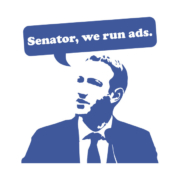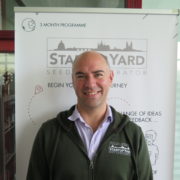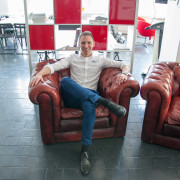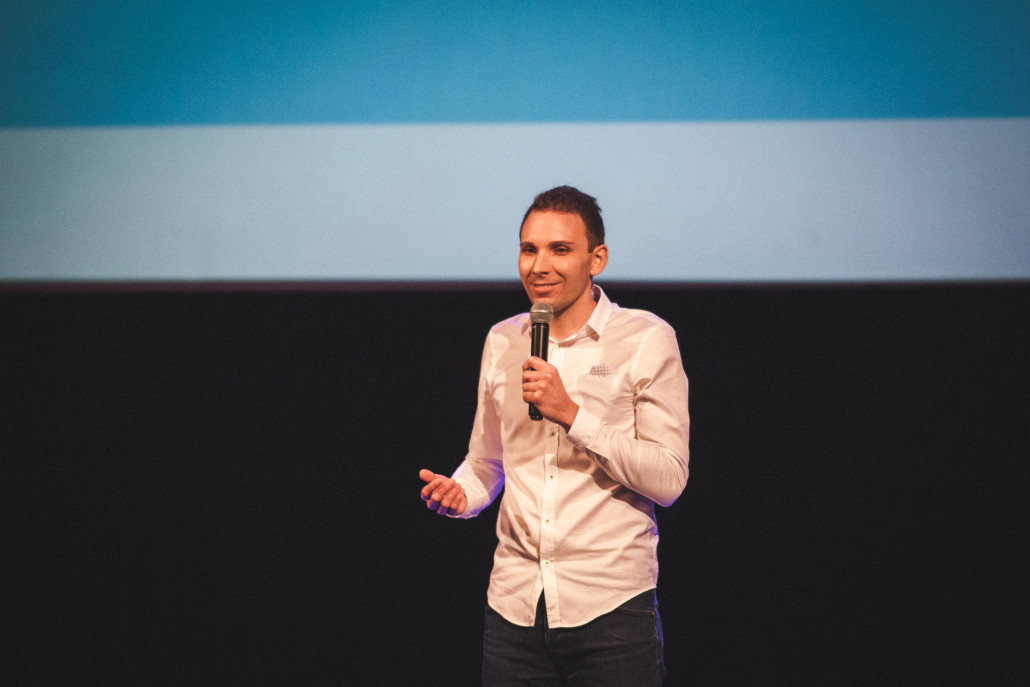Chris Cowles: The Importance of Getting to No
Hi StartupYard people. Hello, current Batch X startups and fellow alumni! The StartupYard Team asked me to share with you some of my accumulated wisdom as a StartupYard alum and a startup founder (Blocknify, Batch 9).
I honestly didn’t think I had a lot to say, especially since my startup Blocknify, which allows people to sign documents securely in the blockchain without their document touching any external server at any time, is still new, and we are still in the early days of acquiring customers and finding our product/market fit.
But I realized as I was preparing to say that I don’t have anything to contribute, that I actually do have one thing to contribute, and that is what I will call “How to get to no.”
How to Get to No
I spent some years as a consultant working with large corporations before co-founding Blocknify. One thing about working in a big corporation is that you never see the whole processes you work on. If you are in sales, then you don’t see the product being made. If you’re in products, you don’t see how sales work.
This leads to a certain way of working and thinking, which I guess I would call “accumulating yeses.” That means, if you’re part of a big organization, you are always trying to find ways to say yes to things. Yes, we can sell you a product. Yes, we can do that feature. Yes, that is a good idea. Etc. Getting a yes from your supervisor or your customer is the goal, and getting a no is a failure.
We like to say “yes,” and we rarely have to say “no.”
As a startup founder, I think the most important thing I have learned so far is that it is incredibly important to get to “no.” In fact, if people are not saying “no,” then it probably means you are missing something.
If you are not saying “no,” then it probably also means you are not focusing as you should.
I want to specify why I think this is an important mindset for startup founders with a few examples.
Getting a No From Customers
A few weeks ago I was invited to meet with an innovation team from a very large company. It doesn’t matter which one. Imagine any big company with millions of customers.
They sort of know that we help organizations handle contracts securely. They also know that handling contracts and agreements is a big struggle for them, both on the customer side and on the supply side as well.
When I show a group like this our product, we get lots of this reaction: “wow this is so great! We need this!” It feels really good, and it’s nice validation that you’re doing something your target users like and want.
Except for one minor problem. Will we make this sale? No way in hell. At least not anytime soon. The customer is just too big, has too many needs, and isn’t ready to work with us, like we aren’t ready to work with them. We have to qualify them out pretty quickly not to waste a lot of our time on something we won’t be able to reasonably do.
Yet this is exactly the kind of situation that is toughest for a first-time startup founder to navigate. That has been my experience because you so want to accumulate those “yes” answers. Even if the yeses you are getting don’t help you that much, we are comforted when we hear it.
When we first started having these sorts of meetings, I think I personally wasted a lot of energy accumulating yeses from people. Do you like it? Yes. Can you show it to someone else at the organization? Yes. Can we talk again? Yes.
Believe me, you can bounce around for a year getting nothing but yes from everyone in the organization, and still, nothing happens.
What you find out quickly is that when people like you and your ideas, they have a lot of ways to say yes, and few ways to really say no. Like: “is it realistic that we will be able to make a deal with someone at your company before we run out of money?” Nobody can answer that honestly. They want to say that they like you and that anything is possible. They don’t want to discourage you.
In startups, not everything is possible. Sorry, not everything is possible. You are time limited. You are resource limited. Picking what is most possible and executing on that takes a lot of focus, which is the only strength you really have as a small company. So I have learned that when I hear “yes,” I need to keep going until I hear a “no.”
For example:
“Do you see this as valuable for your business?”
“Yes.”
“Can we take the next step toward an agreement?”
“Yes.”
“Can we get it signed within 6 months?”
“Yes, it’s possible”
“Can we do it within 3 months?”
“Eh… not sure.”
Ok, so the “me” from my corporate life would stop after the first few questions. Can we move forward? Yes? Great. I got the yes. I don’t need to go further. This results in a lot of back and forth with little action and a lot of energy wasted.
The startup “me” understands now that I have to press forward and get the no, so that I at least understand what I’m really dealing with. What are the actual barriers to this actually happening? They can be small, or they can be way too big.
Qualifying new opportunities out this way takes vulnerability and requires you to be brutally honest with them and yourself. However, I believe people are attracted to vulnerability and honesty. Without bringing the conversation back to reality you are missing out of the other benefits they can provide such as improvements, understanding their sales process, and being advocated for internally or externally.
I think there is this need from startup founders to always be getting good news. You need bad news too. You have to have it to move forward.
Getting to No With Investors
There was a similar learning process with investors. What I thought would happen was that we would pitch to people, and they would either “pass” or “be interested.” If they were interested, I thought that meant that there is a chance of a deal happening.
Sometimes there is zero chance of a deal, but if you don’t get to no, you’ll never figure that out. No one wants to tell you no. Just a lot of time spent making more and more spreadsheets and presentations.
What you learn is that many investors basically never say no to your face. It’s similar to how customers work. Why say no, when you can say, “let’s stay in touch,” or “it’s interesting, but I’m not sure about x.”
Very few investors will just tell you “no, you’re not for us.” You have to make them get to that point of saying no. If you pitch someone, and they have all the information they need, then you need to know what’s going to come next. A no today doesn’t mean a no forever, but a yes today doesn’t mean a deal will happen.
“Do you like the idea and team?”
“Yes.”
“Would you be interested to discuss an investment?”
“Sure.”
“Do we meet your requirements for an investment?”
“We need to determine….”
“Based on our conversations will you participate in this round of funding?”
“No…”
If I don’t get a clear idea of what “no” is, I can’t very well judge how much time I should spend on trying to persuade that investor. Just like the customer, if they can’t buy, then I shouldn’t spend a lot of time trying to sell. I get to no, and I move on from there.
Getting a no does not mean you should necessarily give up. It just clearly establishes what the challenge is and where they stand. Maybe you don’t meet the requirements right now, but you can at least find out what they are. If you don’t ask, you won’t know.
Just recently we got to a “no” with an investor that we liked and liked us. We see this as not the end but the beginning of a new relationship. We will keep them updated and ask for investment advice and connections, which is hard to ask for during investment discussions. If we had not gotten that “no,” then our relationship would not have evolved at all. Now we can move forward.
Sometimes, many times, the investor you are talking to is saying yes, and someone above them is saying no. That’s really important to understand, and to get to the bottom of where the “no” is coming from. Can you work with that no and make it a yes? Or is it not worth your time?
Even when you are ready to make a deal, again, you have to find that limit – that point where they will say no. How do you know the terms you have are the best you can get? How do you know an offer is the last one? Because you asked for something even better, and they said no.
Getting to No with Your Team
Here is yet another way that “getting to no,” is really beneficial for a startup founder.
When you are dealing with your team members, whether it is co-founders or early employees, or whomever, again it is in people’s nature to try and not disappoint you.
As I learned in this process of creating a brand new product out of nothing but an idea, you can ask people like designers or engineers “can we do this?” And the answer will almost always be some form of “yes.”
When you get into the details, you do find out that the answer might as well be “no” in some cases. Can we do this in the required amount of time? Can we do it within our budget? Can we do it safely, securely, etc? Now we start to get to some “no” answers.
That does not just apply to knowing your limits. Sometimes it is about knowing your capabilities and figuring out what it practically takes to accomplish the project:
“Can you do this in a month?”
“Yes.’
“Can you do it in 2 weeks?”
“Yes…”
“Can you do it in 1 week?”
“No.”
If you are managing a team for the first time and trying to understand what you can reasonably accomplish, getting to that lower limit is also important. If I say a month, it might take a month (or more). But if I find out it’s actually possible in two weeks, or one week, then I might get it in that time. People who work for you also need to know what you expect, and what is expected of them. It also can serve as a way to break down and talk through assumptions they may have.
“Can you join us in this startup?”
“Yes.”
“Can you quit your job to do it full time?”
“Yes.”
“Can you put in more than 40 hour weeks for low pay?”
“Well… not sure.”
Love to Hear “No”
One thing I learned in StartupYard was to have and express an opinion that forces your audience to agree or disagree, i.e., be controversial. I have realized more and more the truth in this teaching. The fact you are doing something on your own is already controversial, so why stop there?
You can’t be going with the flow if you are supposed to be disrupting the flow. This even applies to yourself.
Recently I was talking with our designers and I told them to push the limit and forget about all my preferences and suggestions. This process resulted in an amazing redesign. I’m not comfortable with all of it but that is the point. I wanted them to get me to “no.”
Be authentic. You don’t have to be friends with everyone. Don’t “get along” with everybody all the time. Don’t take yes for an answer, basically. Get to the “no.” Find what the limit is on what you can do and what people are comfortable with, and push to that limit as much as you can.
I asked Lloyd if I could keep going with this analogy for a few more pages, and he said “no.”








